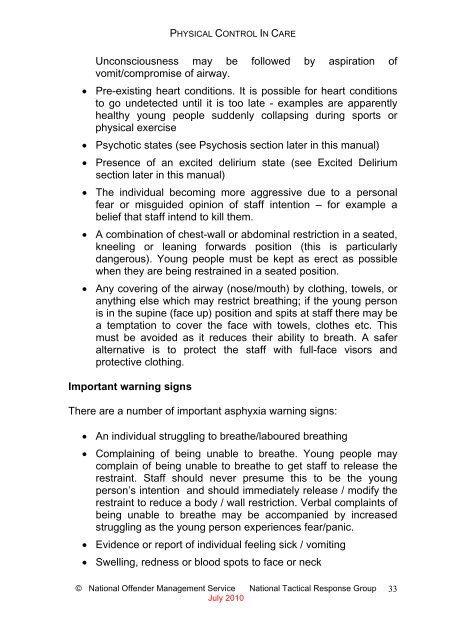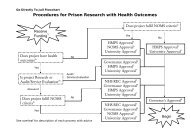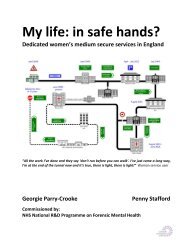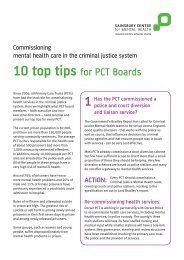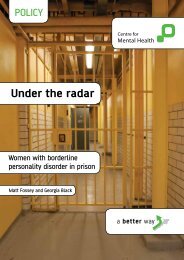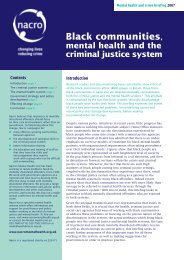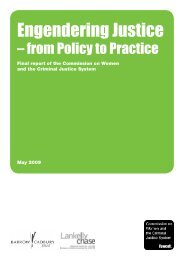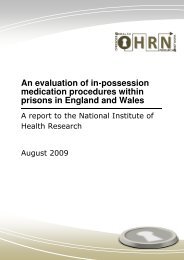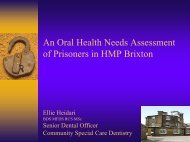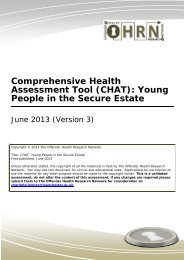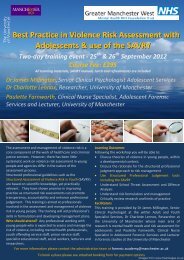Physical Control in Care Training Manual - Independent Advisory ...
Physical Control in Care Training Manual - Independent Advisory ...
Physical Control in Care Training Manual - Independent Advisory ...
Create successful ePaper yourself
Turn your PDF publications into a flip-book with our unique Google optimized e-Paper software.
PHYSICAL CONTROL IN CAREUnconsciousness may be followed by aspiration ofvomit/compromise of airway.• Pre-exist<strong>in</strong>g heart conditions. It is possible for heart conditionsto go undetected until it is too late - examples are apparentlyhealthy young people suddenly collaps<strong>in</strong>g dur<strong>in</strong>g sports orphysical exercise• Psychotic states (see Psychosis section later <strong>in</strong> this manual)• Presence of an excited delirium state (see Excited Deliriumsection later <strong>in</strong> this manual)• The <strong>in</strong>dividual becom<strong>in</strong>g more aggressive due to a personalfear or misguided op<strong>in</strong>ion of staff <strong>in</strong>tention – for example abelief that staff <strong>in</strong>tend to kill them.• A comb<strong>in</strong>ation of chest-wall or abdom<strong>in</strong>al restriction <strong>in</strong> a seated,kneel<strong>in</strong>g or lean<strong>in</strong>g forwards position (this is particularlydangerous). Young people must be kept as erect as possiblewhen they are be<strong>in</strong>g restra<strong>in</strong>ed <strong>in</strong> a seated position.• Any cover<strong>in</strong>g of the airway (nose/mouth) by cloth<strong>in</strong>g, towels, oranyth<strong>in</strong>g else which may restrict breath<strong>in</strong>g; if the young personis <strong>in</strong> the sup<strong>in</strong>e (face up) position and spits at staff there may bea temptation to cover the face with towels, clothes etc. Thismust be avoided as it reduces their ability to breath. A saferalternative is to protect the staff with full-face visors andprotective cloth<strong>in</strong>g.Important warn<strong>in</strong>g signsThere are a number of important asphyxia warn<strong>in</strong>g signs:• An <strong>in</strong>dividual struggl<strong>in</strong>g to breathe/laboured breath<strong>in</strong>g• Compla<strong>in</strong><strong>in</strong>g of be<strong>in</strong>g unable to breathe. Young people maycompla<strong>in</strong> of be<strong>in</strong>g unable to breathe to get staff to release therestra<strong>in</strong>t. Staff should never presume this to be the youngperson’s <strong>in</strong>tention and should immediately release / modify therestra<strong>in</strong>t to reduce a body / wall restriction. Verbal compla<strong>in</strong>ts ofbe<strong>in</strong>g unable to breathe may be accompanied by <strong>in</strong>creasedstruggl<strong>in</strong>g as the young person experiences fear/panic.• Evidence or report of <strong>in</strong>dividual feel<strong>in</strong>g sick / vomit<strong>in</strong>g• Swell<strong>in</strong>g, redness or blood spots to face or neck© National Offender Management Service National Tactical Response GroupJuly 201033


